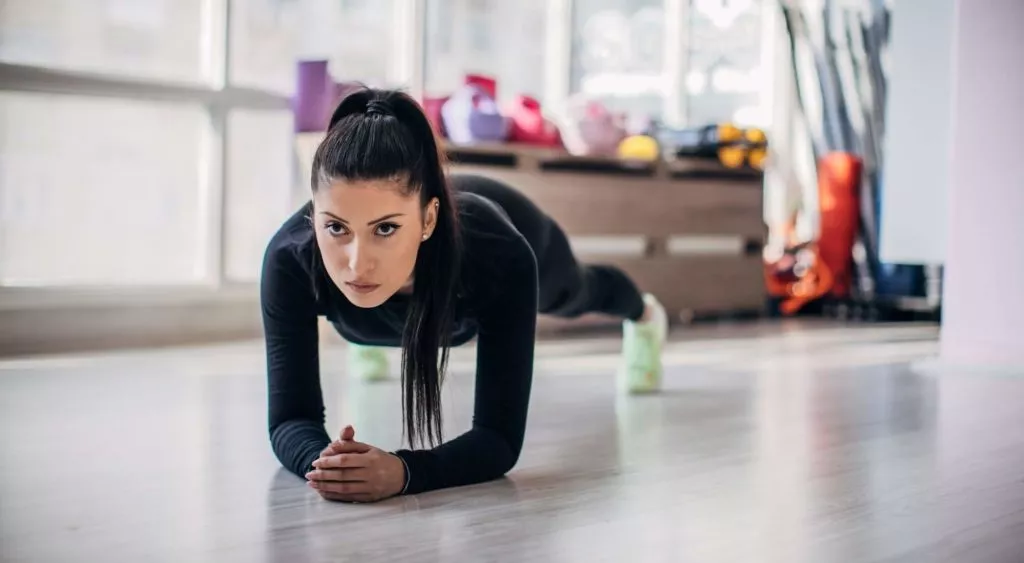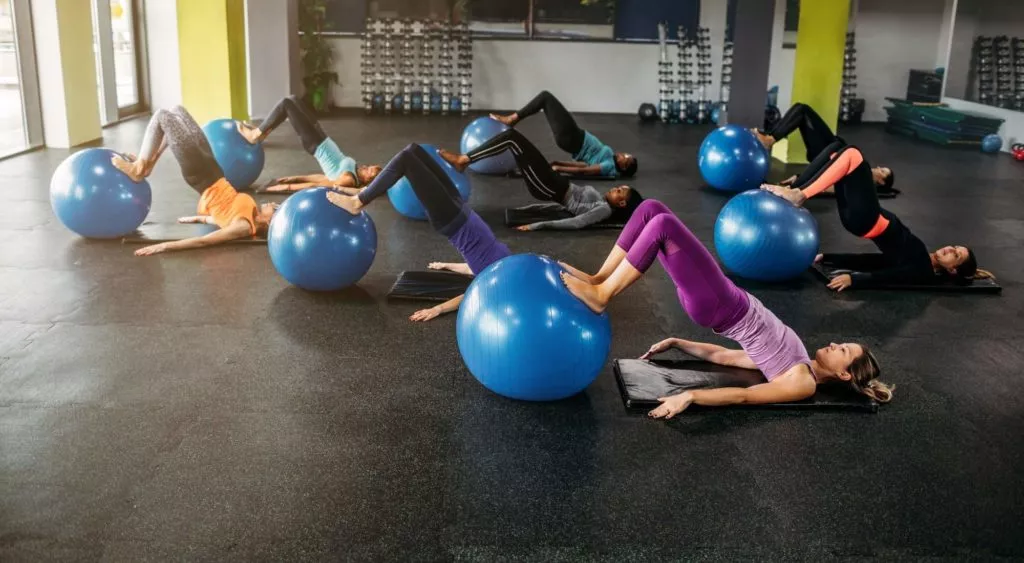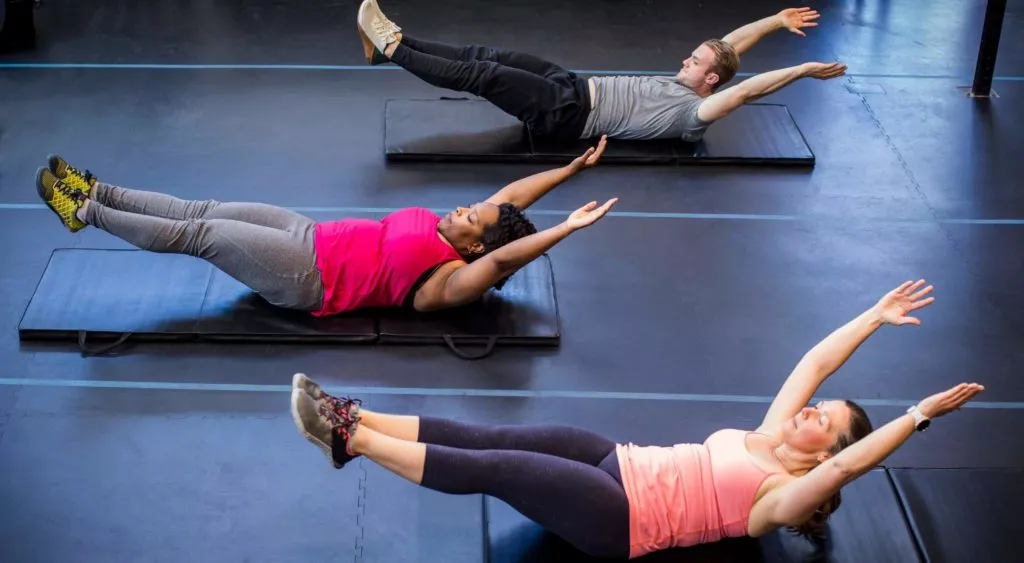
You’ve turned a new leaf and recently decided to commit to a more active lifestyle.
But where do you start?
There are only so many hours in a day and you know signing up for a gym membership would just be a waste.
You’re wondering, “How can a beginner start working out at home?”
This guide will tell you just that. You’ll learn:
- How to do bodyweight training
- The answers to common questions
- Why it’s important to start slow
- An easy, 3-step bodyweight workout plan for beginners
Table of Contents
- The Importance of a Simple Bodyweight Workout for Beginners
- Easy Beginner Bodyweight Workout: Focus on Stabilizers With Dynamic Neuromuscular Stabilization
- Bodyweight Exercise Program for Beginners: Common Questions
- How Do You Do Bodyweight Training?
- Are Bodyweight Workouts Better Than Weights?
- Is It OK To Do Bodyweight Exercises Every Day?
- 3 Step Bodyweight Workout Plan for Beginners
- Step 1: Bodyweight Exercises for Beginners: On Your Back
- Step 2: Bodyweight Exercises for Beginners: On Your Stomach
- Step 3: Bodyweight Exercises for Beginners: On Your Hands and Knees
- Develop a Custom Beginner Bodyweight Exercise Routine With In Motion O.C.

The Importance of a Simple Bodyweight Workout for Beginners
Starting a new workout regimen is really very similar to being a beginner at anything else.
You need to learn to walk before you can run.
Maintaining realistic expectations for yourself and your body are keys to staying on top of your workouts and your results.
If you’re looking for how to build muscle for beginners at home, the real key to getting stronger is by building a solid foundation to work off of.
And that all starts with core stability.
Easy Beginner Bodyweight Workout: Focus on Stabilizers With Dynamic Neuromuscular Stabilization (DNS)
The idea behind focusing on stabilizers comes from something called dynamic neuromuscular stabilization.
DNS sees core stabilization accomplished through the precise coordination of a few different muscles and intra‐abdominal pressure regulated by the central nervous system.
The Rehabilitation Prague School explains DNS by saying: “The nervous system establishes programs that control human posture, movement, and gait.”
“Motor control” is largely established during the first critical years of life.
Therefore, with DNS, you’re mimicking the developmental stages of infants.
You’re building stabilizers just as a baby would as they grow and progress from 1 month to 2 months, 3 months, and so on.
Why is DNS Crucial in a Bodyweight Beginner Routine?
A DNS approach to a bodyweight beginner routine would stimulate movement control centers in the brain to activate how your body was meant to move by restoring and stabilizing locomotor function.
DNS is crucial for both:
- Preventing injury as you learn to build muscle
- Providing a solid baseline for good form
Functional stabilization is required and essential for the movement of your head and limbs, and it’s key to proper spinal support when standing or sitting—meaning you need solid stabilizers not only to complete bodyweight exercises but for everyday movements, too.
Bodyweight Exercise Program for Beginners: Common Questions
No matter what level of fitness you’re starting from, you’re bound to have a few questions about bodyweight programs.
- What benefits are there to bodyweight workouts?
- Are all bodyweight workouts considered full body workouts?
- How often should you do bodyweight workouts?
Read on for answers to a few common questions from beginners.
How Do You Do Bodyweight Training?
Bodyweight exercises are strength-training exercises that use the individual’s own weight to provide resistance against gravity.
Essentially, bodyweight training is where you workout using your body alone without any other exercise equipment.
A quick, even 15-minute, bodyweight workout for beginners can be completed by performing common exercises like:
- Bodyweight squats
- Walking lunges
- Pushups
- Planks
- Jumping jacks
A mixture of circuits, reps, and length of time can all be adjusted to challenge or ease up your bodyweight workout.
Are Bodyweight Workouts Better Than Weights?
The quick answer is—it depends.
When trying to find your answer to “Is bodyweight training better than weightlifting?” the correct answer for you will depend on your ultimate goal.
If you’re recovering from an injury or are a beginner, chances are bodyweight workouts are going to help you achieve your goals more effectively.
But if you’re aiming for muscle gain, bodyweight workouts won’t get you there because you can’t load any of your moves to make them more challenging.
Moreover, bodyweight training also enhances:
- Balance
- Agility
- Flexibility
Using equipment, on the other hand, allows you to track your progress and increase the load to maximize your results.
Narrowing in on your ultimate goal will help point you to which program is best.
Is It OK To Do Bodyweight Exercises Every Day?
While you can work out every day, don’t do the same types of workouts on consecutive days. You don’t build muscle when you’re exercising, you build muscle when you’re resting, so try not to do a strength training bodyweight workout (especially the same muscles) two days in a row.

3-Step Bodyweight Workout Plan for Beginners
It is important to start a bodyweight workout with exercises on your…
- Back
- Stomach; and
- Hands and knees
…before moving to more advanced workouts.
Starting in these three positions will allow you to build a strong core (literally) foundation to build off of.
Step 1: 3 Bodyweight Exercises for Beginners — On Your Back
You’ll start on your back for all three of these bodyweight exercises.
For these, and other common bodyweight moves, you’ll focus on your glutes and work both major core muscles as well as stabilizer muscles.
Stabilizer muscles include your:
- Pelvic floor
- Transverse abdominis; and
- Diaphragm
You can’t see any of these just by looking at your stomach, but they all play a major supporting role in helping your trunk move as efficiently as possible.
#1: Bridges
Any variation of bridges work here.
To perform a traditional bridge:
- Lie on your back, with your legs bent to 90 degrees and your feet flat on the floor.
- Lift your hips and back off the floor until your body forms a straight line from your shoulders to your knees.
- Hold the position for five to 10 seconds.
As you get stronger, you can increase the time you hold the position or add in small pulses.
#2: Abdominal Exercises
You can probably list at least five different types of common abdominal exercises off the top of your head right now.
They range from:
- Traditional crunches
- Bicycle crunches
- Heel touches
- Butterfly crunches
- Leg lifts
- Core roll-ups
- Single-leg jackknifes
- Sit-ups
And the list goes on.
While they can all vary on what part of your core they are targeting (side, lower, upper) they all focus on building your abdominal muscles.
Remember to use your breathing to help you while you do these exercises!
Exhale with the exertion, or when the effort is the most challenging, and inhale to recover.
#3: Dead Bugs
Dead bugs target the core and help with both hip and shoulder mobility.
Get in a starting position by:
- Lying face up with your arms extended toward the ceiling and your legs in a tabletop position (knees bent 90 degrees and stacked over your hips).
- Slowly extend your right leg out straight, while simultaneously lowering your left arm overhead. Keep both a few inches from the ground. Squeeze your butt and keep your core engaged the entire time, with your lower back pressed into the floor.
- Bring your arm and leg back to the starting position.
- Repeat on the other side, extending your left leg and your right arm.
Step 2: 3 Bodyweight Exercises for Beginners — On Your Stomach
Typically, when you’re performing an exercise from a stomach start position, you’re going to be targeting your posterior chain.
Think of muscles like your:
- Hamstrings
- Glutes
- Posterior deltoids
- Traps
- Calves
- Lats
- Rotator cuffs
The muscles in the posterior chain play a huge role in your everyday movements.
Think of things as simple as picking something up off the ground, sitting down and standing back up, or jumping.
The posterior chain also works to protect your knees and back from injury.
#1: Superman
Supermans are a really effective move to target multiple areas of the body.
They work to strengthen your:
- Upper and lower back muscles
- Hamstrings
- Glutes
There are a couple of different ways you can perform this exercise.
For one:
- Lie on your front, with your arms and legs extended.
- Raise your head, your right arm, and your left leg about 10-15 cm off the floor.
- Hold for a count of three, then lower back down to the start position.
- Repeat with your left arm and right leg.
For another variation:
- Lie on your front, with your arms and legs extended.
- Raise your head, both arms, and both legs about 10-15 cm off the floor.
- Hold for a count of three, then lower back down to the start position.
- Repeat.
#2: Stability Ball Reverse Extensions
- Position yourself face down over a stability ball with your hands on the floor and spaced shoulder-width apart.
- Lie with your stomach on the stability ball and place your hands on the floor.
- Lift your feet up until you form a straight line between your feet, hips, and shoulders (you can bend your arms to help the range of motion).
- Hold the top position for a few seconds.
- Lower your feet with control.
#3: Bow Pose
This pose targets your anterior spine but focuses mostly on your:
- Legs
- Back
- Glutes
No matter how deep you are able to go in this particular pose, it is going to both stretch your muscles and build strength.
To start:
- Lie on your stomach on a yoga mat. Pad your hips with a blanket if necessary.
- Press your tailbone forward firmly and engage your abdominal muscles.
- Bend your knees and press your heels back toward your buttocks.
- Reach behind you with both hands and grab the outside of your feet.
- Use the strength of your core muscles to lift both your upper body and legs off of the ground.
Depending on how flexible your muscles naturally are, you may find that you can’t get your legs off the ground.
Keep practicing and, eventually, your legs will rise.

Step 3: 3 Bodyweight Exercises for Beginners — On Your Hands and Knees
Finally, exercises on your hands and knees typically truly work the whole body.
Whether you’re working to balance or holding in a hover, all of your muscle groups are working together to build strength.
Keep reading for your last three bodyweight exercises to try.
#1: Bird Dogs
This move targets both the core and the glutes.
Give it a go by following the steps below:
- Start on your hands and knees in a tabletop position with your wrists stacked under your shoulders and your knees stacked under your hips.
- Extend your right arm forward and left leg back, maintaining a flat back and keeping your hips in line with the floor.
- Squeeze your abs and draw your right elbow and left knee in to meet near the center of your body.
- Reverse the movement and extend your arm and leg back out.
- Continue this movement for a set amount of time, then repeat with the other arm and leg.
#2: Planks
Just like with other abdominal exercises, there is no limit to the amount of plank variations available to you.
Each target different areas of the core and other parts of your body including…
- Core
- Latissimus dorsi
- Glutes; and
- Deltoids
…and they can all be adjusted to fit your fitness level and as you progress.
A few common variations include:
- Bear plank
- Side plank
- Elbow plank
Planks typically consist of holding your body in an isolated position for a set amount of time.
They help work to strengthen your spine which will naturally result in a strong posture.
#3: Table-Top Knee Taps
This exercise works much like a plank to strengthen the core with the added bonus of leg movement.
To get in position:
- Start on all fours with your palms flat on the floor and your wrists and elbows directly beneath shoulders.
- Your knees should be directly below the hips with toes tucked and pressed into the mat.
- Keep your neck long and neutral. This is your start position.
- With core tight, lift knees up off the mat so that hips are in line with shoulders. Hover for one to two seconds, then release knees to the ground.
That’s one rep.
If you want to modify and increase the difficulty of this move, just hold in a hover for longer.
Develop a Custom Beginner Bodyweight Exercise Routine With In Motion O.C.
In Motion O.C. offers several fitness programs featuring workouts co-designed by physical therapists, postural specialists, and fitness coaches.
We will meet you where you are in your fitness journey and build a complete beginner bodyweight workout plan specifically tailored to help you reach your goals.
Our goals are to help our clients:
- Look and feel better.
- Improve their posture, balance, flexibility, cardiovascular endurance, and function.
- Prevent reoccurrence of pain and injury.
Let us help you reach your goals. Contact us to schedule your free consultation.



